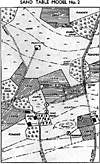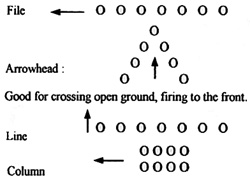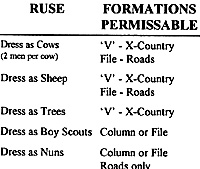Introduction
The origins of this game lay in Heather`s portrayal of her grandfather, who was by all accounts very much the picture of a Scottish Captain Mainwaring. Not only was he a Captain in the local Home Guard, but the Manager of the Royal Bank of Scotland in Inverness to boot! The idea was born gradually as Graham Hockley took his popular "Who Do You Think...." Dad`s Army game around the shows, and following a windfall of a whole heap of Home Guard publications including training manuals landing in my lap.
You probably won`t be surprised to find that this game is a little tongue in cheek and whilst designed to be solo, can be expanded into a fun multi-player game. Try it with three identical platoons running round a table at the same time to see what I mean.
Disclaimer
Any similarity to any classic BBC comedy series from the seventies starring Arthur Lowe or Felicity Kendal is entirely unintentional and purely a cruel figment of a distorted imagination.
What You`ll Need To Play
FIGURES
The minimum number of figures is seven - Captain McMainwaring and the six main characters. I added 3 more privates to represent "McSponge" and the lads of the second row etc. The Vicar, McHodges, various Boy Scouts / Nuns / Sheep / Pantomime cows / Umpires and Red Forces Home Guard etc. all add to the visual appeal, but scraps of paper, cards, counters will suffice.
Depending upon how much you get into playing the game, 20mm will probably be the best scale if only because most of the figure types you will need are available from various sources. For figures I recommend Peter Pig`s 15mm Home Guard pack from their WW2 range, with umpires, brass and officials coming from the SCW Republican Senior Officers pack. In 20mm, both Raventhorpe and SDD have dedicated Home Guard ranges, but in truth any WW2 British Tommies in battledress will do, particularly early war types. Irregular have a burgeoning 20mm civillian range including priests and nuns. McHodges can be any figure in battledress and a tin helmet - with webbing etc, shaved off.
CARDS
An inexpensive way of making up the cards required for games such as this, which can be used over and over, is to buy a cheap pack of playing cards - £1 and some AVERY style address labels. I use the P.C. to print labels out, but you can simply write on them and just stick them to the front of the playing cards.
RUSE CARDS
You may have a sinking feeling in your colon when Corporal McJones claims to have another idea, but listen to the old veteran as this could be your chance to "Get out of trouble quick."
Ruse cards allow you to use that native cunning that will "pull the wool over Jerries eyes" should the balloon ever go up.
ENEMY CARDS
One has to be on the watch-out as the enemy can take all forms of disguises don`t you know. Anyway, I`m sure that McHodges fellow is a German spy!
McHODGES: (Three Cards) The town ARP Warden, hates the Home Guard and will do anything to discredit Captain McMainwaring.
VICAR : (Two Cards) Well intentioned but often interferes with or gets in the way of the smooth running of this crack fighting formation.
MRS MCPIKE : (One Card) McPike`s doting mother. May arrive at inopportune moments to give Frank his scarf.
ROADBLOCK: (Two Cards) 1xAvD of East Tay mob
DEFENDED BRIDGE : (One card per bridge) 1xAvD of East Tay, Home Guard Platoon.
The Balloon`s Gone Up: (one card) 1xAvD Jerry Parachutists (Optionally dressed as Nuns)
UMPIRE:
Very necessary to make sure the game proceeds with the correct amount of humour. Basically, give the player`s a quick briefing and a small card highlighting formations etc. Keep most of the actual mechanics of the game to yourself and reveal effects of actions etc. only if you have to. When running the game play the event and charcater cards against the player/s at random. All character cards must be accompanied by the lines spoken as per character. To add a bit of period flavour use party poppers to represent thunderflashes / grenades, a garden gate type bolt operated as quickly as possible to simulate rifle bolts and a tin containing gravel for machine-gun fire (genuine Dad`s Army training aid this). Oh yeah, alcohol helps.
Game Sequence
- 1. Roll Command Points
2. Decide Formation, Direction, Speed
3. Roll for Event
4. Actions
Captain McMainwaring
You play the role of Captain McMainwaring. Cast in the heroic mould, you are determined to show the "EastTay Mob" a thing or two by leading your brave lads of the Walmington on Tay "platoon" to the objective. You know that whilst there are a few characters in your platoon, they are basically good men and just need a firm hand to keep them under control. Now, where is that McWilson?
COMMAND POINTS
McMainwaring`s ability to command his platoon is reflected in the number of Command Points (CPs). CP`s are crucial to move the platoon, change formation and get into action should the enemy appear.
McMainwaring starts the game with a set number of Command Points - 5 - which reflect his control over his men and the overall situation. An Average die is rolled each turn and added to the number of Command Points.
It may not be prudent to use all your Command Points before the end of each turn as a dicey situation may result from a drawn EVENTS card but nothing one with your experience can`t handle I`m sure.
Command Point Track
[1] |
[2] |
[3] |
[4] |
[5] |
[6] |
[7] |
[8] |
RIPOSTES
Up your sleeve are a number of well delivered ripostes which if used correctly nullify the effects of a drawn character card. These are kept as a second deck, shuffled and face down. When a charcter card is played, you may chose one RIPOSTE card at random. If it suits the occasion you null the character card and may add 1 permenantly to your Command Points total. It not, you lose one CP that turn. Here are some, I let you decide which charcter cards they are best suited to nullify.
- "I was waiting to see how long it would take you to think of that Wilson"
"Stupid Boy"
"That`s enough of that"
"McJones ! Pull yourself together"
"Right McWilson, get the men fell in"
THE FIELD OF BATTLE
 The map should give you an idea of the type of terrain to construct. For a quick play through, roughly copy the map onto a large sheet of paper, - old rolls of wallpaper are fine here, colour in with felt pens, then use as a playing surface.
The map should give you an idea of the type of terrain to construct. For a quick play through, roughly copy the map onto a large sheet of paper, - old rolls of wallpaper are fine here, colour in with felt pens, then use as a playing surface.
Fields are separated by hedges (Southern England) or walls (North of England, Wales and Scotland). This counts as both cover and as an obstacle. Rivers and streams can only be crossed by a ford or bridge.
FORMATIONS
There are four formations permissable to the platoon based upon those in the Infantry Section Leading (HMSO, 1938). Anyone whose served in the British Army at any time since then will recognise that nothing`s changed !


Formation may be changed at the halt or on the move. To change formation, the player must bet a number of CP`s from Mainwaring`s Command Point total and roll beneath that with 1xD6. If successful, remaining CP`s can be used for movement or actions. If unsuccessful, the platoon must halt and use up the remaining CP`s to sort out the chaos.
MOVEMENT
Easy. 1xAvD + CP`s x Formation Multiplier
The Formation Multiplier can be found in the table below, just cross reference formation by terrain type. Treat crossing obstacles, walls, hedges etc as a die roll against a given number of CP`s in a similar manner to changing formation.
| Formation | CP`s | |||||
|---|---|---|---|---|---|---|
| Road | Grass | Crops | Ploughed | Copse | Farm | |
| Arrowhead | XXX | x 1 | x 1/2 | x 1/2 | x 1/2 | XXX |
| Line | XXX | x 1.5 | x 1 | x 1/2 | x 1/2 | x 1/2 |
| File | x 3 | x 2 | x 1.5 | x 1 | x 1 | x 1.5 |
| Column | x 3 | x 2 | >x 1.5 | x 1 | x 1 | x 1 |
EVENTS
The Ruse, Character and Enemy cards are all mixed together with an equal number of blank cards to create the Events Deck. At the end of each turn, pick one card from the deck.
Unfortunately there are too many possibilities for me to list all that can happen with the Events cards in the available space. Here are some examples :
If the platoon are dressed as nuns, they`re rumbled by the Vicar. MacMainwaring must roll beneath his Command Point Total not to lose 1CP (embarrasment) - if the East Tay mob are near by then they come under fire etc. The Vicar will also rumble German Paras dressed as nuns too ! If Franks Mum turns up, again she gives the game away, waving that infernal scarf about.
Mr Brown..... provides the framework...you provide the script!
THEY DON`T LIKE IT UP `EM
Fire must be conducted when stationary. The platoon will come under fire from
any enemy that spots it (hence Ruses). The platoon may also engage any enemy it observes in turn.
Platoon Giving Fire : No. of CP`s allowed for fire from McMainwaring`s Command Points Total x Formation Modifier in table below = Fire Points:
Now Roll 2xD6.
If roll below or equal Fire Points, then enemy loses one casualty - 2 if Umpire Card drawn
Roll above no. of Fire Points = No Effect
If Platoon Under Fire : then as above but enemy must roll over the number of Fire Points.
i.e. 4 CPs x 2 = 8 Fire Points - Platoon must score 8 or below to hit, enemy firing then 9 or more. If total = 12 or greater then automatic "casualty".
| Formation | C.P. | Road | Grass | Crops | Ploughed | Copse | Farm |
|---|---|---|---|---|---|---|---|
| Arrowhead | Under Fire | XXX | x 1 | x 1 | x 1 | x 1/2 | XXX |
| Giving Fire | XXX | x 2 | x 2 | x 2 | x 1 | XXX | |
| Line | Under Fire | XXX | x 1 | x 1 | x 1 | x 1/2 | x 1/2 |
| Giving Fire | XXX | x 3 | x 3 | x 3 | x 2 | x 2 | |
| File | Under Fire | x 2 | x 1.5 | x 1.5 | x 1.5 | 1/2 | 1/2 |
| Giving Fire | x 1/2 | x 1 | x 1 | x 1 | 1/2 | 1/2 | |
| Column | Under Fire | x 3 | x 2 | x 2 | x 2 | x 1 | x 1 |
| Giving Fire | x 1/2 | x 1 | x 1 | x 1 | XXX | x 1/2 |
| Character Cards | |||
|---|---|---|---|
| CHARACTER | PHRASE / ACTION | EFFECT | NR. of CARDS |
| Sergeant McWilson | "May I Make A Suggestion Here Sir ?" | A tactically sound suggestion which you of course thought of first. +1AvD CP`s next turn. | 4 |
| Sergeant McWilson | "Oh Really, Must We Sir ?" | Cost 3 CP`s | 3 |
| Corporal McJones | "They Don`t Like It Up `Em !" | Cost 2 CP`s: Jones mops up the enemy with cold steel* | 3 |
| Corporal McJones | "Don`t Panic ! Don`t Panic!" | Cost 3 CP`s | 3 |
| Corporal McJones | "Permission to Volunteer Sir !" | Cost 2 CP`s | 2 |
| Corporal McJones | McJones Gets into Trouble | Cost 4 CP`s | 2 |
| Pvte McPike | "Mum`s Not Going To Like This Uncle Arthur" | Cost 3 CP`s | 3 |
| Pvte McPike | Frank Comes Up Trumps | McPike appears behind the enemy with Tommy gun making "Na-Na-Na-Na-Na" noises. +2 CPs* | 1 |
| Pvte McPike | McPike Gets into Trouble | Cost 3 CP`s | 1 |
| Pvte McGodfrey | "Would You Like Some of My Sister Dolly`s Upside Down Cake ?" | Cost 1 CP | 2 |
| Pvte McGodfrey | "May I Be Excused Please Sir ? " | Cost 1 CP | 1 |
| Pvte McFraser | "We`re All Doomed ! Doomed !" | Cost 1 CP | 4 |
| Pvte McFraser | "The Man`s A Fool" | Cost 1 CP | 3 |
| Pvte McWalker | "Arf A Mo !" | Cost 2 CP | 2 |
| Pvte Mcwalker | Fag Break | Cost 1 CP | 3 |
| Pvte McWalker | "Come on Jonesy": | McWalker & McJones Do Their Bit - Capture The Enemy +2 CP`s | 2 |
Back to The Gauntlet No. 9 Table of Contents
Back to The Gauntlet List of Issues
Back to Master Magazine List
© Copyright 1997 by Craig Martelle Publications
This article appears in MagWeb (Magazine Web) on the Internet World Wide Web.
Other military history articles and gaming articles are available at http://www.magweb.com